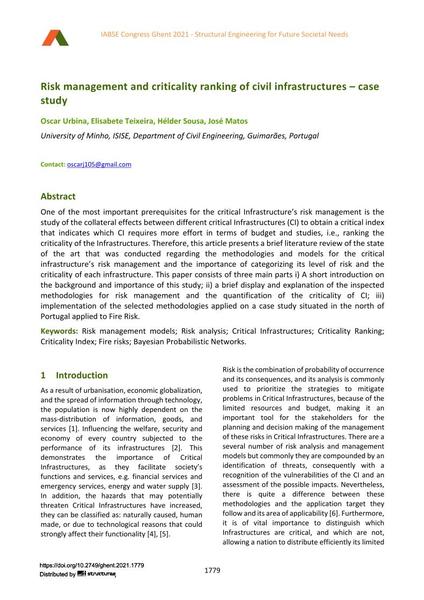Risk management and criticality ranking of civil infrastructures – case study

|
|
|||||||||||
Détails bibliographiques
| Auteur(s): |
Oscar Urbina
(University of Minho, ISISE, Department of Civil Engineering, Guimarães, Portugal)
Elisabete Teixeira (University of Minho, ISISE, Department of Civil Engineering, Guimarães, Portugal) Helder Sousa José Matos |
||||
|---|---|---|---|---|---|
| Médium: | papier de conférence | ||||
| Langue(s): | anglais | ||||
| Conférence: | IABSE Congress: Structural Engineering for Future Societal Needs, Ghent, Belgium, 22-24 September 2021 | ||||
| Publié dans: | IABSE Congress Ghent 2021 | ||||
|
|||||
| Page(s): | 1779-1788 | ||||
| Nombre total de pages (du PDF): | 10 | ||||
| DOI: | 10.2749/ghent.2021.1779 | ||||
| Abstrait: |
One of the most important prerequisites for the critical Infrastructure’s risk management is the study of the collateral effects between different critical Infrastructures (CI) to obtain a critical index that indicates which CI requires more effort in terms of budget and studies, i.e., ranking the criticality of the Infrastructures. Therefore, this article presents a brief literature review of the state of the art that was conducted regarding the methodologies and models for the critical infrastructure’s risk management and the importance of categorizing its level of risk and the criticality of each infrastructure. This paper consists of three main parts i) A short introduction on the background and importance of this study; ii) a brief display and explanation of the inspected methodologies for risk management and the quantification of the criticality of CI; iii) implementation of the selected methodologies applied on a case study situated in the north of Portugal applied to Fire Risk. |
||||
| Copyright: | © 2021 International Association for Bridge and Structural Engineering (IABSE) | ||||
| License: | Cette oeuvre ne peut être utilisée sans la permission de l'auteur ou détenteur des droits. |
||||
